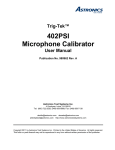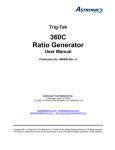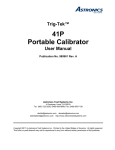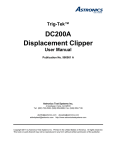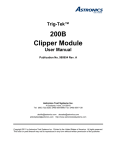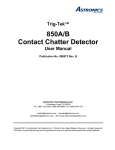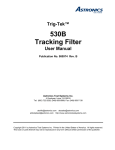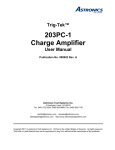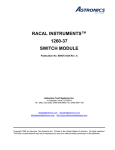Download 402H Microphone Calibrator User Manual
Transcript
Trig-Tek™ 402H Microphone Calibrator User Manual Publication No. 980963 Rev. A Astronics Test Systems Inc. 4 Goodyear, Irvine, CA 92618 Tel: (800) 722-2528, (949) 859-8999; Fax: (949) 859-7139 [email protected] [email protected] [email protected] http://www.astronicstestsystems.com Copyright 2011 by Astronics Test Systems Inc. Printed in the United States of America. All rights reserved. This book or parts thereof may not be reproduced in any form without written permission of the publisher. THANK YOU FOR PURCHASING THIS ASTRONICS TEST SYSTEMS PRODUCT For this product, or any other Astronics Test Systems product that incorporates software drivers, you may access our web site to verify and/or download the latest driver versions. The web address for driver downloads is: http://www.astronicstestsystems.com/support/downloads If you have any questions about software driver downloads or our privacy policy, please contact us at: [email protected] WARRANTY STATEMENT All Astronics Test Systems products are designed to exacting standards and manufactured in full compliance to our AS9100 Quality Management System processes. This warranty does not apply to defects resulting from any modification(s) of any product or part without Astronics Test Systems express written consent, or misuse of any product or part. The warranty also does not apply to fuses, software, non-rechargeable batteries, damage from battery leakage, or problems arising from normal wear, such as mechanical relay life, or failure to follow instructions. This warranty is in lieu of all other warranties, expressed or implied, including any implied warranty of merchantability or fitness for a particular use. The remedies provided herein are buyer’s sole and exclusive remedies. For the specific terms of your standard warranty, contact Customer Support. Please have the following information available to facilitate service. 1. Product serial number 2. Product model number 3. Your company and contact information You may contact Customer Support by: E-Mail: [email protected] Telephone: +1 800 722 3262 (USA) Fax: +1 949 859 7139 (USA) RETURN OF PRODUCT Authorization is required from Astronics Test Systems before you send us your product or sub-assembly for service or calibration. Call or contact Customer Support at 1-800-722-3262 or 1-949-859-8999 or via fax at 1-949-859-7139. We can also be reached at: [email protected]. If the original packing material is unavailable, ship the product or sub-assembly in an ESD shielding bag and use appropriate packing materials to surround and protect the product. PROPRIETARY NOTICE This document and the technical data herein disclosed, are proprietary to Astronics Test Systems, and shall not, without express written permission of Astronics Test Systems, be used in whole or in part to solicit quotations from a competitive source or used for manufacture by anyone other than Astronics Test Systems. The information herein has been developed at private expense, and may only be used for operation and maintenance reference purposes or for purposes of engineering evaluation and incorporation into technical specifications and other documents which specify procurement of products from Astronics Test Systems. TRADEMARKS AND SERVICE MARKS All trademarks and service marks used in this document are the property of their respective owners. • Racal Instruments, Talon Instruments, Trig-Tek, ActivATE, Adapt-A-Switch, N-GEN, and PAWS are trademarks of Astronics Test Systems in the United States. DISCLAIMER Buyer acknowledges and agrees that it is responsible for the operation of the goods purchased and should ensure that they are used properly and in accordance with this document and any other instructions provided by Seller. Astronics Test Systems products are not specifically designed, manufactured or intended to be used as parts, assemblies or components in planning, construction, maintenance or operation of a nuclear facility, or in life support or safety critical applications in which the failure of the Astronics Test Systems product could create a situation where personal injury or death could occur. Should Buyer purchase Astronics Test Systems product for such unintended application, Buyer shall indemnify and hold Astronics Test Systems, its officers, employees, subsidiaries, affiliates and distributors harmless against all claims arising out of a claim for personal injury or death associated with such unintended use. FOR YOUR SAFETY Before undertaking any troubleshooting, maintenance or exploratory procedure, read carefully the WARNINGS and CAUTION notices. This equipment contains voltage hazardous to human life and safety, and is capable of inflicting personal injury. If this instrument is to be powered from the AC line (mains) through an autotransformer, ensure the common connector is connected to the neutral (earth pole) of the power supply. Before operating the unit, ensure the conductor (green wire) is connected to the ground (earth) conductor of the power outlet. Do not use a two-conductor extension cord or a three-prong/two-prong adapter. This will defeat the protective feature of the third conductor in the power cord. Maintenance and calibration procedures sometimes call for operation of the unit with power applied and protective covers removed. Read the procedures and heed warnings to avoid “live” circuit points. Before operating this instrument: 1. Ensure the proper fuse is in place for the power source to operate. 2. Ensure all other devices connected to or in proximity to this instrument are properly grounded or connected to the protective third-wire earth ground. If the instrument: - fails to operate satisfactorily shows visible damage has been stored under unfavorable conditions has sustained stress Do not operate until performance is checked by qualified personnel. Publication No. 980963 Rev. A Microphone Calibrator User Manual Table of Contents Chapter 1 .........................................................................................................................1-1 Introduction .....................................................................................................................1-1 Description ..................................................................................................................................... 1-1 Dimensions ................................................................................................................................ 1-1 Weight ........................................................................................................................................ 1-1 Theory of Operation ....................................................................................................................... 1-2 Chapter 2 .........................................................................................................................2-1 Operation .........................................................................................................................2-1 General Information........................................................................................................................ 2-1 Charger & Battery ........................................................................................................................... 2-1 Percent LED’s ................................................................................................................................ 2-1 Test Manifold .................................................................................................................................. 2-3 Test Method ................................................................................................................................... 2-3 KNOWN Microphone ...................................................................................................................... 2-3 Extended Transducer ..................................................................................................................... 2-4 Controls .......................................................................................................................................... 2-5 POWER Switch .......................................................................................................................... 2-5 Frequency Selector .................................................................................................................... 2-5 Level Selector............................................................................................................................. 2-5 External Frequency Switch......................................................................................................... 2-5 Chapter 3 .........................................................................................................................3-1 Performance Test............................................................................................................3-1 Test Equipment .............................................................................................................................. 3-1 Switch Settings ............................................................................................................................... 3-1 Frequency Test Procedure ............................................................................................................. 3-2 Level Test Procedure ..................................................................................................................... 3-2 Chapter 4 .........................................................................................................................4-1 Calibration Procedure ....................................................................................................4-1 Conversion ..................................................................................................................................... 4-1 Test Equipment .......................................................................................................................... 4-1 Calibration Procedure ..................................................................................................................... 4-2 Setting the 160 dB Level ............................................................................................................ 4-2 Setting Frequency ...................................................................................................................... 4-2 Astronics Test Systems i 402H Microphone Calibrator User Manual Publication No. 980963 Rev. A List of Figures Figure 1-1, 402H Microphone Calibrator – Front Layout ....................................................................1-2 Figure 2-1, 402H Battery Life Data at 1000 Hz ...................................................................................2-2 Figure 2-2, 402H Cable Assembly ......................................................................................................2-4 ii Astronics Test Systems Publication No. 980963 Rev. A Microphone Calibrator User Manual List of Tables Table 2-1, Sound Transducer Frequency Response (Nominal)......................................................... 2-3 Table 4-1, Transducer Conversion Table........................................................................................... 4-1 Astronics Test Systems iii 402H Microphone Calibrator User Manual Publication No. 980963 Rev. A DOCUMENT CHANGE HISTORY iv Revision Date A 12/5/2011 Description of Change Document Control release Astronics Test Systems Publication No. 980963 Rev. A 402H Microphone Calibrator User Manual Chapter 1 Introduction Description The 402H Microphone Calibrator (Figure 1-1) is designed to provide portable calibration of high intensity microphones and pressure transducers. Modified to add flexibility to the original 402A design, the 402H offers the ability to extend the sound source up to twenty five feet from the base unit using a provided cable. The 402H is housed in a portable carrying case (12" x 12" x 7.5") and is designed to provide storage for the hand held sound transducer and extension cable. The 402H Microphone Calibrator is capable of delivering sound pressure levels from 120 dB to 160 dB selectable in 10 dB increments and is accurate to ±1.0 dB. The test manifold, which interfaces both the unknown and reference microphones to the sound transducer, is designed so that both microphones share a common cavity. The output of the reference or "known" microphone is used in a closed loop control to maintain an accurate sound pressure level in the test manifold. Five internal frequencies: 62.5, 125, 250, 500 and 1000 Hz are selectable from the front panel. A BNC connector is provided to accommodate an external frequency source. The 402H is completely self contained and comes with the following components: Hand held sound transducer (with fitted cover), 25' cable (with storage pouch), wrist strap, cable stress relief strap, rechargeable lead acid battery, reference pressure transducer test manifold, microphone adapter (of your choice), calibration plug and power cord. Dimensions Case 12'' x 12" wide x 7.5" high Sound Transducer 4.5" dia. x 5.5" high Case 23 lbs. with sound transducer Sound Transducer 6 lbs Weight Astronics Test Systems Introduction 1-1 402H Microphone Calibrator User Manual Publication No. 980963 Rev. A Figure 1-1, 402H Microphone Calibrator – Front Layout Theory of Operation The 402H has an oscillator with a selector to set in five frequencies 62.5, 125, 250, 500, and 1000 Hz. The signal generated by the oscillator is sent to an AGC (Automatic Gain Control) circuit that controls the signal level of the transducer driver circuit. The reference microphone senses the sound pressure level in the test manifold at the output of the transducer. The output of the reference microphone is amplified and then rectified by the true RMS AC to DC converter and compared to a reference voltage. Any error from the comparison causes the compressor, via the AGC circuit to increase or decrease the input to the drive circuit until the DC from the converter matches the reference, thus maintaining a known, fixed sound pressure level in the test manifold. Because of the nature of the driver transducer, the output can have up to 5% Introduction 1-2 Astronics Test Systems Publication No. 980963 Rev. A 402H Microphone Calibrator User Manual distortion. By using a true root means square conversion at the AC to DC converter, the distortion can only alter the level by the square root of the sum of the components squared; for instance if the signal component is 1 and the distortion component is .10% or .1, the level change will be .05% change, so the distortion has a very small effect on the control level. Because the 10 dB step will be controlled by gain changes, the sound pressure level for each 10 dB step will be as accurate as the gain set for each step which can be held ±1%. Therefore, the accuracy of the sound pressure level generated at the reference microphone is controlled by a preset reference voltage and the gain of the microphone amplifier. Both the reference voltage and the gain can be controlled very accurately. So the calibration accuracy of the system will ultimately be the precision of the reference microphone. Astronics Test Systems Introduction 1-3 402H Microphone Calibrator User Manual Publication No. 980963 Rev. A This page was left intentionally blank. Introduction 1-4 Astronics Test Systems Publication No. 980963 Rev. A 402H Microphone Calibrator User Manual Chapter 2 Operation General Information For proper operation, it is necessary that the microphone to be tested be installed in the test manifold with the appropriate microphone adapter. If there are any questions regarding proper microphone adapters, contact the manufacturer. Charger & Battery The 402H Microphone Calibrator can be operated with AC or DC power. It has a rechargeable lead acid battery which will operate for up to four hours on a single charge. AC requirements are 115 to 230 VAC at 50 to 400 Hz. An internal switch marked S1, internally located next to the power transformer allows you to switch between 115 and 230 VAC operation. The unit is set to 115 V at the factory. A LOW BATT LED illuminates when the battery is completely discharged. CAUTION Do not operate the charger with 230 VAC of power if switch (S1) is in the 115 V position. Damage may result to the charger and/or battery. NOTE: Do not allow the battery to remain completely discharged for more than 3-4 hours. This can result in permanent damage to the battery. Percent LED’s The percent charge LED circuit provides continual monitoring of the battery charge. Four LED's display above 80, 60, 40, and 20 percent charge. The 0 percent LED illuminates when the battery voltage is below operating level. See Figure 2-1 to determine the battery life. Astronics Test Systems Operation 2-1 402H Microphone Calibrator User Manual Publication No. 980963 Rev. A Figure 2-1, 402H Battery Life Data at 1000 Hz Operation 2-2 Astronics Test Systems Publication No. 980963 Rev. A 402H Microphone Calibrator User Manual Test Manifold The 402H is equipped with a test manifold which interfaces the known and unknown microphones to the sound transducer. In this manifold, the two microphones share a common cavity and are located adjacent to one another. The known microphone fits securely in the manifold with a metal hold down nut. The unknown microphone must be installed using an adapter made specially for the microphone being tested. For best results, an air tight seal is desired between the microphone to be tested and its adapter. These adapters can be purchased from EADS North America Test and Services. Custom adapters will be considered on request. Test Method The known microphone is measured using a True RMS Detector. In order to get an accurate comparison, it will be necessary to measure the unknown microphone with a charge amplifier that also has True RMS Detection. In the case that the unknown transducer is a millivolt type, a current source will be needed. An EADS North America Test and Services 203M Charge Amplifier or equivalent is recommended. KNOWN Microphone The reference (KNOWN) microphone used in the 402H is a MIC62 (OEM from Dytran Instruments). The sensitivity and certificate of calibration for the microphone will be shipped with the unit. Manufacturer specified accuracy of this microphone is ±0.5 dB @ 120,130, 140, 150 and 160 dB SPL (Sound Pressure Level). The calibration is in peak millivolts lb/in 2 . Table 2-1, Sound Transducer Frequency Response (Nominal). Astronics Test Systems SPL dB Frequency Range 160 20-2000 150 20-2500 140 20-3000 130 20-3000 120 20-4000 Operation 2-3 402H Microphone Calibrator User Manual Publication No. 980963 Rev. A Extended Transducer The 402H provides a portable transducer to allow testing microphones that are installed. A 25-foot cable is standard (Figure 2-2). Other length cables can be supplied on special order. Figure 2-2, 402H Cable Assembly Operation 2-4 Astronics Test Systems Publication No. 980963 Rev. A 402H Microphone Calibrator User Manual Controls POWER Switch The POWER switch is a two position switch marked ON and OFF. In the ON position, the unit will operate in either mode, AC or DC. The LED next to the ON marker should illuminate. In the OFF position, the unit is ready to charge. The LOW BATT Led will illuminate when the battery charge drops below a usable level. Frequency Selector This five position rotary switch allows selection of the available internal frequencies: 62.5, 125, 250, 500 and 1000 Hz. Level Selector This five position rotary switch allows selection of dB level from 120 to 260 in 10 dB increments. External Frequency Switch This switch allows the use of an external frequency source. In the (INT) position, the internal oscillator is activated making five frequencies selectable from the front panel, 62.5, 125, 250, 500 and 1000 Hz. In the (EXT) position, the corresponding BNC connector is activated making it possible to introduce a signal from an outside source. External frequency input voltage is 5 Volts RMS. Astronics Test Systems Operation 2-5 402H Microphone Calibrator User Manual Publication No. 980963 Rev. A This page was left intentionally blank. Operation 2-6 Astronics Test Systems Publication No. 980963 Rev. A 402H Microphone Calibrator User Manual Chapter 3 Performance Test This Performance Test Procedure should be run to verify that the unit is performing within the manufactured specifications. The unit uses integrated circuits and very stable parts and should not require calibration more than once every six months, unless a part fails. In the event that a reading is out of tolerance the unit may require calibration see (Chapter 4) of this manual. Test Equipment Equivalent test equipment may be substituted. Digital Multimeter Keithley 179 (TRMS) Frequency counters Fluke 1900A Switch Settings Prior to turning the 360C power ON, set the switches to the following: • Frequency Hertz switch to 1000 • dB SPL switch to 160 • INT/EXT switch to INT • POWER switch to ON. After you turn the POWER switch to ON, verify that the Power LED is ON and BATT LOW LED is OFF. Note: Since we are checking the performance of the 402H using the KNOWN microphone secured in the test manifold, the other two ports must be plugged. Use either plugs provided or the UNKNOWN microphone. Astronics Test Systems Performance Test 3-1 402H Microphone Calibrator User Manual Publication No. 980963 Rev. A Frequency Test Procedure 1. Connect frequency counter and multimeter to microphone output. 2. Observe the 1000 ±50.0 Hz indication on the frequency counter. 3. Place the FREQ HZ Switch to 500. 4. Observe the 500 ±25.0 Hz indication on the HZ FREQ counter. 5. Place the FREQ HZ Switch to 250. 6. Observe the 250 ±12.5 Hz indication on the FREQ counter. 7. Place the FREQ HZ Switch to 125. 8. Observe the 125 ±6.25 Hz indication on the FREQ counter. 9. Place the FREQ HZ switch to 62.5. 10. Observe the 62.5 ±3.125 Hz indication on the FREQ counter. Level Test Procedure In order to test output levels you must refer to Operation (Chapter 2) of this manual. Using the Conversion table (Table 4-1 in Chapter 4), determine millivolts for 160 dB-120 dB SPL. The sensitivity of the KNOWN microphone is given on the calibration certificate (2013M9 Dytran). Example: A microphone with sensitivity of 750 mV/ lb/in 2 . = 217.6 mV/160 dB. .29 x (sen) mV/lb/in 2 . = mV for 160 dB SPL. 1. Place dB SPL switch to 160. 2. Observe (calculated mV/160 dB) ±5% on the multimeter at the microphone output. 3. Repeat Steps 1 and 2 for 150 dB, 140 dB, 130 dB, and 120 dB. Performance Test 3-2 Astronics Test Systems Publication No. 980963 Rev. A 402H Microphone Calibrator User Manual Chapter 4 Calibration Procedure The Calibration of the 402H is based on the traceability of the Reference Microphone. Because the calibration of the Reference Microphone is done in static mV / lb / in 2 units, it is necessary to do the conversion to SPL dB. Conversion The units commonly used to calibrate microphones and pressure transducers are static millivolts/lbs/in 2 . It will be necessary to convert these units to mV/ SPL dB. A conversion table and explanation is offered below. It has been established that 2.9 x 10 −9 mV RMS/ Ib/in 2 = 0 dB SPL RMS, because the microphone is calibrated using static pressure. The following method should provide the proper conversion. Table 4-1, Transducer Conversion Table mV/160 dB = .29 x mV/lb/in 2 mV/150 dB = .092 x mV/lb/in 2 mV/140 dB = .029 x mV/lb/in 2 mV/130 dB = .0092 x mV/lb/in 2 mV/120 dB = .0029 x mV/lb/in 2 Test Equipment Equivalent test equipment can be substituted. TRMS Meter Keithley 179A Digital Counter Leader LDC-822 Astronics Test Systems Calibration Procedure 4-1 402H Microphone Calibrator User Manual Publication No. 980963 Rev. A Calibration Procedure Setting the 160 dB Level 1. With the power OFF and the Reference microphone in place, insert the calibration plug in the manifold in place of the UNKNOWN microphone. 2. Place the FREQ Hz selector to 500. 3. Place the dB SP LEVEL switch to 160. 4. Place the POWER switch to ON. 5. Connect the TRMS AC voltmeter to the MIC OUTPUT jack. 6. Set the 160 dB ADJ for the Peak or RMS millivolt number found in the above calculation ±I% on the TRMS AC voltmeter. NOTE: Set R2 on the OSC & Driver Assembly for the proper range. Setting Frequency Note: Remove the unit from the case prior to beginning this calibration. 1. Place the FREQ HZ selector to 62.5 Hz. 2. Leave the dB SP LEVEL switch set to 160 dB. 3. Connect the counter to the MIC OUTPUT jack. 4. Adjust R2 for 62.5 ±1.8 Hz. 5. Place the FREQ HZ selector to 125 Hz. 6. Adjust R6 for 125 ±3.7Hz. 7. Place the FREQ HZ selector to 250 Hz. 8. Adjust R5 for 250 ±7.5 Hz. 9. Place the FREQ HZ selector to 500 Hz. 10. Adjust R4 for 500 ±15 Hz. 11. Place the FREQ Hz selector to 1000 Hz. 12. Adjust R3 for 1000 Hz ±30 Hz. Calibration Procedure 4-2 Astronics Test Systems






















